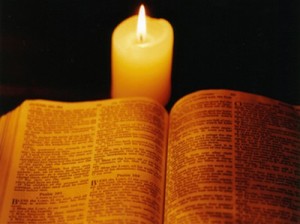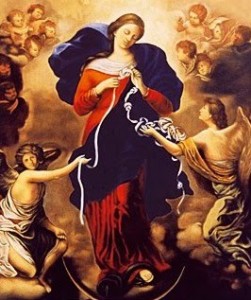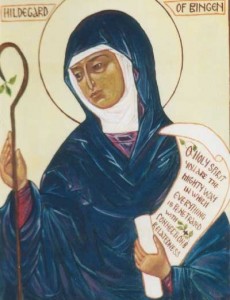I love this feast day of the Blessed Virgin Mary!!!
The Presentation of the Blessed Virgin Mary (as it is known in the West), or The Entry of the Most Holy Theotokos into the Temple (its name in the East), is a liturgical feast celebrated by the Roman Catholic and Orthodox Churches.
wiki - The feast is associated with an event recounted not in the New Testament, but in the apocryphal
Infancy Narrative of James. According to that text, Mary’s parents, Joachim and Anne, who had been childless, received a heavenly message that they would bear a child. In thanksgiving for the gift of their daughter, they brought her, when still a child, to the Temple in Jerusalem to consecrate her to God. Mary remained in the Temple until puberty, at which point she was assigned to Joseph as guardian. Later versions of the story (such as the Gospel of Pseudo-Matthew and the Gospel of the Nativity of Mary) tell us that Mary was taken to the Temple at around the age of three in fulfillment of a vow.
The feast originated as a result of the dedication of the Basilica of Saint Mary the New, built in the year 543 by the Byzantines under Emperor Justinian I near the site of the ruined Temple in Jerusalem. Although this
basilica was destroyed by the Sassanid Persians under Khosrau II after the Siege of Jerusalem (614), the feast continued to be celebrated throughout the East. The feast was celebrated in the monasteries of Southern Italy by the ninth century and was later introduced into the Papal Chapel in Avignon in the year 1372 by a decree of Pope Gregory XI. Â It was included in the Roman Missal in 1472. But, as the fact of the “Presentation of the Blessed Virgin Mary” is only a pious belief, but not a defined matter of faith, it was suppressed by Pope Pius V in 1568. Â As a result, it did not appear in the Tridentine Calendar. Pope Sixtus V reintroduced it into the Roman Calendar in 1585. Pope Clement VIII made this feast a Greater Double in 1597. The
feast also continued as a memorial in the Roman Calendar of 1969.
Entry of the Most Holy Theotokos into the Temple (Russian icon, 16th century).The Eastern Orthodox Church celebrates it as one of its twelve Great Feasts on November 21 (for those churches which follow the Julian Calendar, November 21 falls on December 4 of the modern Gregorian Calendar). The first documented celebration of the feast in any calendar is the mention of the Εἴσοδος τῆς Παναγίας Θεοτόκου (Entry of the All-Holy Theotokos – i.e. into the Temple) in the 11th-century Menology of the Eastern Roman (also known as Byzantine) emperor Basil II. In the Orthodox Church the feast always falls during the Nativity Fast, and on the day of the feast the fasting rules are lessened somewhat so that fish, wine and oil may be eaten.
For the Roman Catholic Church, on the day of the Presentation of the Blessed Virgin Mary, “we celebrate that dedication of herself which Mary made to God from her very childhood under the inspiration of the Holy Spirit who filled her with grace at her Immaculate Conception.”
November 21 is also a “Pro Orantibus” Day, a day of prayer for cloistered religious “totally dedicated to God in prayer, silence and concealment.”
The Presentation in art
Western depictions usually focused on the lone figure of the young Mary climbing the steep steps of the Temple, having left her parents at the bottom, and climbing towards the Chief Priest and other Temple figures at the top of the steps. The Presentation was one of the usual scenes in larger cycles of the Life of the Virgin, although it was not usually one of the scenes shown in a Book of hours. – wiki
Collect:
Eternal Father,
we honor the holiness and glory of the Virgin Mary.
May her prayers bring us
the fullness of your life and love.
We ask this through our Lord Jesus Christ, your Son, who
lives and reigns with You and the Holy Spirit,
one God, for ever and ever. Amen.
First Reading: Zechariah 2:14-17 (2:10-13 RSV)
Sing and rejoice, O daughter of Zion; for lo, I come and I will dwell in the midst of you, says the Lord. And many nations shall join themselves to the Lord in that day, and shall be My people; and I will dwell in the midst of you, and you shall know that the Lord of hosts has sent Me to you. And the Lord will inherit Judah as His portion in the holy land, and will again choose Jerusalem.”
Be silent, all flesh, before the Lord; for He has roused Himself from His holy dwelling.
Gospel Reading: Matthew 12:46-50
While He was still speaking to the people, behold, His mother and His brethren stood outside, asking to speak to Him. But He replied to the man who told Him, “Who is My mother, and who are My brethren?” And stretching out His hand toward His disciples, He said, “Here are My mother and My brethren! For whoever does the will of My Father in heaven is My brother, and sister, and mother.”
Tags: blessed virgin mary, catholic, catholic podcast, catholic prayer, cathollc spirituality, holy spirit, Holy Theotokos, prayer, presentation of the blessed virgin mary, Roman Catholic, silence, The Presentation of the Blessed Virgin Mary
This entry was posted on Monday, November 21st, 2011 at 12:07 am
You can follow any responses to this entry through the RSS 2.0 feed.
“Why is this granted me, that the mother of my Lord should come to me?”
[powerpress feed=”daily-scripture”]
an excerpt from today’s reflection by Don Schwager:
Do you recognize the indwelling presence of the Lord Jesus in your life? Blessed are you if you see and recognize the Lord with the “eyes of faith”. The word “blessed” [makarios in Greek] literally means “happiness” or “beatitude”. It describes a kind of joy which is serene and untouchable, self-contained, and independent from chance and changing circumstances of life. There is a certain paradox for those “blessed” by the Lord. Mary was given the “blessedness” of being the mother of the Son of God. That blessedness also would become a sword which pierced her heart as her Son died upon the cross. Anselm, a great teacher and Archbishop of Canterberry (1033-1109), spoke these words in a homily: “Without God’s Son nothing could exist; without Mary’s son, nothing could be redeemed.” To be chosen by God is an awesome privilege and responsibility. Mary received both a crown of joy and a cross of sorrow. Her joy was not diminished by her sorrow because it  was fueled by her faith, hope, and trust in God and his promises. Jesus promised his disciples that “no one will take your joy from you” (John 16:22). The Lord gives us a supernatural joy which enables us to bear any sorrow or pain and which neither life nor death can take away. Do you know the joy of a life given over to God in faith and trust?
was fueled by her faith, hope, and trust in God and his promises. Jesus promised his disciples that “no one will take your joy from you” (John 16:22). The Lord gives us a supernatural joy which enables us to bear any sorrow or pain and which neither life nor death can take away. Do you know the joy of a life given over to God in faith and trust?
What is the significance of Mary’s visit to her cousin Elizabeth before the birth of Jesus? When Elizabeth greeted Mary and recognized the Messiah in Mary’s womb they were filled with the Holy Spirit and with a joyful anticipation of the fulfilment of God’s promise to give a Savior. What a marvelous wonder for God to fill not only Elizabeth’s heart with his Holy Spirit but the child in her womb as well. John the Baptist, even before the birth of the Messiah, pointed to his coming and leapt for joy in the womb of his mother as the Holy Spirit revealed to him the presence of the King to be born. The Holy Spirit is God’s gift to us to enable us to know and experience the indwelling presence of God and the power of his kingdom. The Holy Spirit is the way in which God reigns within each of us. Do you live in the joy and knowledge of God’s indwelling presence with you through his Holy Spirit?
“Lord Jesus, fill me with your Holy Spirit and give me joy in seeking you more closely. Increase my faith in all your promises, my hope in the joys of heaven, and my love for You as my All.”
for the full reflection visit : Daily Reading and Meditation
Tags: catholic, catholic podcast, catholic prayer, cathollc spirituality, don schwager, faith, gospel of luke, holy spirit, joy, mother
This entry was posted on Tuesday, May 31st, 2011 at 12:29 am
You can follow any responses to this entry through the RSS 2.0 feed.
The Fifth Monday in Ordinary Time – from the Gospel of Mark the full reading and reflection
“Immediately the people recognized Jesus”
an excerpt from today’s reflection by Don Schwager: 
Faith is an entirely free gift which God makes to us through the power of the Holy Spirit. Believing and trusting in God to act in our lives is only possible by the grace and help of the Holy Spirit who moves the heart and converts it to God. The Holy Spirit opens the eyes of the mind and helps us to understand, accept, and believe God’s word. How do we grow in faith? By listening to God’s word with trust and submission. Faith also grows through testing and perseverance. The Lord wants to teach us how to pray in faith for his will for our lives and for the things he wishes to give us to enable us to follow him faithfully and serve him generously. Jesus gave his disciples the perfect prayer which acknowledges God as our Father who provides generously for his children. The Lord’s prayer teaches us to seek first the kingdom of God and to pray that God’s will be accomplished in our lives. The Lord in turn, gives us what we need to live each day for his glory. The Lord is never too distant nor too busy to meet us and to give his blessing. Do you pray to the Father with confidence that he will show you his will and give you what you need to follow him? Ask the Lord to increase your faith and gratitude for his merciful love and provision for your life.
“Lord Jesus, let my heart sing for joy in your presence. Give me eyes of faith to recognize your presence and fill me with your Holy Spirit that I may walk in your way of love and peace.”
for the full reflection visit : Daily Reading and Meditation
Tags: catholic, catholic podcast, catholic prayer, cathollc spirituality, don schwager, gospel of mark, holy spirit, Lord Jesus, the Holy Spirit
This entry was posted on Monday, February 7th, 2011 at 12:01 am
You can follow any responses to this entry through the RSS 2.0 feed.
 Click here for the complete text and audio for the Mary, Untier of Knots Novena
Click here for the complete text and audio for the Mary, Untier of Knots Novena
Sign of the Cross
Act of Contrition
Nineth day:
Bible reading:
« 14 All of these together gave themselves to constant prayer. With them were some women and also Mary, the mother of Jesus, and his brothers…» and »when the day of Pentecost arrived, all were filled with the Holy Spirit.» (Acts 1:14 and 2:1-4)
Brief Reflection:
Our Father sends the Holy Spirit on the feast of Pentecost , that will feed us in our faith. This is the same faith that with Mary’s maternal help, will remove the bonds that keep us prisoners. With the light of the Holy Spirit we see in meridian clarity which of our anguishes had our spirit trapped. The guidance of Saint Michael the Archangel has always been certain, Saint Gabriel the Archangel will announce my freedom and Saint Michael the Archangel, will protect me from any attack. The Evil one (the serpent), overpowered by the presence of Mary, lies at her feet, made into a useless knot, unable to touch us.
( Brief meditation: meditate with one decade of the Holy Rosary: One Our Father, 10 Hail Mary’s, One Glory be and the Prayer to “The Virgin Mary untier of Knotsâ€)
Tags: audio, blessed mother, catholic, catholic podcast, catholic prayer, cathollc spirituality, day of Pentecost, faith, freedom, holy spirit, mary undoer of knots, mary untier of knots, Saint Michael the Archangel, The Virgin Mary, virgin mary
This entry was posted on Saturday, January 8th, 2011 at 12:03 am
You can follow any responses to this entry through the RSS 2.0 feed.
 Once again the Holy Father, Pope Benedict XVI speaks of the importance of St. Hildegard of Bingen.
Once again the Holy Father, Pope Benedict XVI speaks of the importance of St. Hildegard of Bingen.
Vatican City – Pope Benedict’s General Audience from Vatican.va
Dear Brothers and Sisters, Today I would like to take up and continue my Reflection on St Hildegard of Bingen, an important female figure of the Middle Ages who was distinguished for her spiritual wisdom and the holiness of her life. Hildegard’s mystical visions resemble those of the Old Testament prophets: expressing herself in the cultural and religious categories of her time, she interpreted the Sacred Scriptures in the light of God, applying them to the various circumstances of life. Thus all those who heard her felt the need to live a consistent and committed Christian lifestyle. In a letter to St Bernard the mystic from the Rhineland confesses: “The vision fascinates my whole being: I do not see with the eyes of the body but it appears to me in the spirit of the mysteries…. I recognize the deep meaning of what is expounded on in the Psalter, in the Gospels and in other books, which have been shown to me in the vision. This vision burns like a flame in my breast and in my soul and teaches me to understand the text profoundly” (Epistolarium pars prima I-XC: CCCM 91). Hildegard’s mystical visions have a rich theological content. They refer to the principal events of salvation history, and use a language for the most part poetic and symbolic. For example, in her best known work entitled Scivias, that is, “You know the ways” she sums up in 35 visions the events of the history of salvation from the creation of the world to the end of time. With the characteristic traits of feminine sensitivity, Hildegard develops at the very heart of her work the theme of the mysterious marriage between God and humanity that is brought about in the Incarnation. On the tree of the Cross take place the nuptials of the Son of God with the Church, his Bride, filled with grace and the ability to give new children to God, in the love of the Holy Spirit (cf. Visio tertia: PL 197, 453c).
From these brief references we already see that theology too can receive a special contribution from women because they are able to talk about God and the mysteries of faith using their own particular intelligence and sensitivity. I therefore encourage all those who carry out this service to do it with a profound ecclesial spirit, nourishing their own reflection with prayer and looking to the great riches, not yet fully explored, of the medieval mystic tradition, especially that represented by luminous models such as Hildegard of Bingen.
The Rhenish mystic is also the author of other writings, two of which are particularly important since, like Scivias, they record her mystical visions: they are the Liber vitae meritorum (Book of the merits of life) and the Liber divinorum operum (Book of the divine works), also called De operatione Dei. In the former she describes a unique and powerful vision of God who gives life to the cosmos with his power and his light. Hildegard stresses the deep relationship that exists between man and God and reminds us that the whole creation, of which man is the summit, receives life from the Trinity. The work is centred on the relationship between virtue and vice, which is why human beings must face the daily challenge of vice that distances them on their way towards God and of virtue that benefits them. The invitation is to distance themselves from evil in order to glorify God and, after a virtuous existence, enter the life that consists “wholly of joy”. In her second work that many consider her masterpiece she once again describes creation in its relationship with God and the centrality of the human being, expressing a strong Christo-centrism with a biblical-Patristic flavour. The Saint, who presents five visions inspired by the Prologue of the Gospel according to St John, cites the words of the Son to the Father: “The whole task that you wanted and entrusted to me I have carried out successfully, and so here I am in you and you in me and we are one” (Pars III, Visio X: PL 197, 1025a). Finally, in other writings Hildegard manifests the versatility of interests and cultural vivacity of the female monasteries of the Middle Ages, in a manner contrary to the prejudices which still weighed on that period. Hildegard took an interest in medicine and in the natural sciences as well as in music, since she was endowed with artistic talent. Thus she composed hymns, antiphons and songs, gathered under the title: Symphonia Harmoniae Caelestium Revelationum (Symphony of the Harmony of Heavenly Revelations), that were performed joyously in her monasteries, spreading an atmosphere of tranquillity and that have also come down to us. For her, the entire creation is a symphony of the Holy Spirit who is in himself joy and jubilation.
The popularity that surrounded Hildegard impelled many people to seek her advice. It is for this reason that we have so many of her letters at our disposal. Many male and female monastic communities turned to her, as well as Bishops and Abbots. And many of her answers still apply for us. For instance, Hildegard wrote these words to a community of women religious: “The spiritual life must be tended with great dedication. At first the effort is burdensome because it demands the renunciation of caprices of the pleasures of the flesh and of other such things. But if she lets herself be enthralled by holiness a holy soul will find even contempt for the world sweet and lovable. All that is needed is to take care that the soul does not shrivel” (E. Gronau, Hildegard. Vita di una donna profetica alle origini dell’età moderna, Milan 1996, p. 402). And when the Emperor Frederic Barbarossa caused a schism in the Church by supporting at least three anti-popes against Alexander iii, the legitimate Pope, Hildegard did not hesitate, inspired by her visions, to remind him that even he, the Emperor, was subject to God’s judgement. With fearlessness, a feature of every prophet, she wrote to the Emperor these words as spoken by God: “You will be sorry for this wicked conduct of the godless who despise me! Listen, O King, if you wish to live! Otherwise my sword will pierce you!” (ibid., p. 412). With the spiritual authority with which she was endowed, in the last years of her life Hildegard set out on journeys, despite her advanced age and the uncomfortable conditions of travel, in order to speak to the people of God. They all listened willingly, even when she spoke severely: they considered her a messenger sent by God. She called above all the monastic communities and the clergy to a life in conformity with their vocation. In a special way Hildegard countered the movement of German cátari (Cathars). They cátari means literally “pure” advocated a radical reform of the Church, especially to combat the abuses of the clergy.
She harshly reprimanded them for seeking to subvert the very nature of the Church, reminding them that a true renewal of the ecclesial community is obtained with a sincere spirit of repentance and a demanding process of conversion, rather than with a change of structures. This is a message that we should never forget. Let us always invoke the Holy Spirit, so that he may inspire in the Church holy and courageous women, like St Hildegard of Bingen, who, developing the gifts they have received from God, make their own special and valuable contribution to the spiritual development of our communities and of the Church in our time.
Tags: catholic, catholic podcast, catholic prayer, cathollc spirituality, Church, courageous women, Hildegard of Bingen, holy spirit, mysteries, mystic of the Church, mystics, pope benedict, pope benedict xvi, st hildegard of bingen, women, women of the middle ages
This entry was posted on Wednesday, September 8th, 2010 at 4:08 pm
You can follow any responses to this entry through the RSS 2.0 feed.



